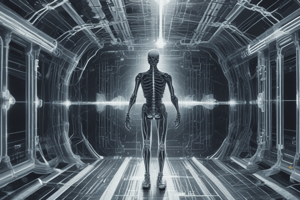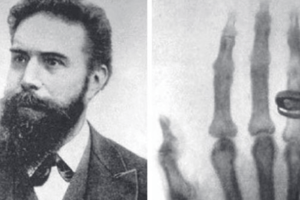Podcast
Questions and Answers
What is the primary function of collimation in X-ray procedures?
What is the primary function of collimation in X-ray procedures?
- To increase the intensity of the X-ray beam for better image quality.
- To filter out unnecessary electromagnetic radiation to protect the patient.
- To accelerate the speed at which X-rays are produced, shortening the procedure time.
- To shape and restrict the size of the X-ray beam, reducing the volume of tissue irradiated. (correct)
Which of the following is a characteristic of stochastic effects from radiation exposure?
Which of the following is a characteristic of stochastic effects from radiation exposure?
- They manifest only when the radiation dose exceeds a certain high threshold.
- They do not exhibit a dose threshold; any dose has a potential risk. (correct)
- They exhibit a dose threshold; below the threshold, no effects are observed.
- The severity of the effect is directly proportional to the dose received.
In the context of X-ray production, what is the role of the filament in the cathode?
In the context of X-ray production, what is the role of the filament in the cathode?
- To control the kilovoltage (kV) settings of the X-ray tube.
- To heat up and emit electrons when a low-voltage current is applied. (correct)
- To accelerate electrons towards the target in the anode.
- To convert the energy of electrons into X-ray photons.
Which of the following best describes 'radiopaque' in the context of dental radiographs?
Which of the following best describes 'radiopaque' in the context of dental radiographs?
Why are dentists likely to manage patients undergoing radiation therapy or chemotherapy?
Why are dentists likely to manage patients undergoing radiation therapy or chemotherapy?
What distinguishes deterministic effects of radiation from stochastic effects?
What distinguishes deterministic effects of radiation from stochastic effects?
What is the most significant contributor to medical radiation exposure?
What is the most significant contributor to medical radiation exposure?
Which principle of radiation safety emphasizes the importance of reducing unnecessary exposure to patients and staff?
Which principle of radiation safety emphasizes the importance of reducing unnecessary exposure to patients and staff?
What is the primary mechanism by which indirect actions of ionizing radiation cause biological damage?
What is the primary mechanism by which indirect actions of ionizing radiation cause biological damage?
A dentist is planning treatment for a patient who will undergo radiation therapy for head and neck cancer. Which consideration is MOST important when designing the treatment plan?
A dentist is planning treatment for a patient who will undergo radiation therapy for head and neck cancer. Which consideration is MOST important when designing the treatment plan?
Why does fractionation of the total X-ray dose provide greater tumor destruction?
Why does fractionation of the total X-ray dose provide greater tumor destruction?
Which of the following defines electron binding energy?
Which of the following defines electron binding energy?
What is the relationship between tube current (mA) and the number of X-rays produced?
What is the relationship between tube current (mA) and the number of X-rays produced?
What is the most common cause of biological damage from radiation?
What is the most common cause of biological damage from radiation?
What effect does decreasing the tissue volume exposed during dental radiography have on the resulting image?
What effect does decreasing the tissue volume exposed during dental radiography have on the resulting image?
Flashcards
What is Matter?
What is Matter?
Anything that occupies space and has mass.
Electron binding energy
Electron binding energy
Energy needed to overcome electrostatic force binding electrons to the nucleus.
Radiation
Radiation
Transmission of energy through space and matter, in electromagnetic or particulate forms.
Types of Electromagnetic Radiation
Types of Electromagnetic Radiation
Signup and view all the flashcards
X-ray Machine Components
X-ray Machine Components
Signup and view all the flashcards
High Voltage in X-ray Production
High Voltage in X-ray Production
Signup and view all the flashcards
Low Voltage in X-ray Production
Low Voltage in X-ray Production
Signup and view all the flashcards
X-Ray Tube Controls
X-Ray Tube Controls
Signup and view all the flashcards
Collimation
Collimation
Signup and view all the flashcards
Radiolucent Appearance
Radiolucent Appearance
Signup and view all the flashcards
Radiopaque Appearance
Radiopaque Appearance
Signup and view all the flashcards
Direct Actions of Radiation
Direct Actions of Radiation
Signup and view all the flashcards
Indirect Actions of Radiation
Indirect Actions of Radiation
Signup and view all the flashcards
Stochastic Effects
Stochastic Effects
Signup and view all the flashcards
Deterministic Effects
Deterministic Effects
Signup and view all the flashcards
Study Notes
- Matter is defined as anything with mass that occupies space
- Atoms are the basic building blocks of matter and consist of a nucleus surrounded by electrons
- The nucleus contains protons and neutrons
- Electrons are bound to the nucleus by electrostatic forces
- Electron binding energy is the amount of energy required to overcome the electrostatic force that binds an electron to the nucleus
- Radiation is the transmission of energy through space and matter, occurring in electromagnetic and particulate forms
Types of Electromagnetic Radiation
- Electromagnetic radiation includes gamma rays, X-rays, ultraviolet rays, visible light, infrared radiation, microwaves, and radio waves
X-Ray Machine Components
- The main parts of an X-ray machine are the tube head, power supply, and control panel
- High voltage is used to stream electrons from the filament in the cathode to the target in the anode to produce X-rays, where energy converts to X-rays
- Low voltage heats the filament to incandescence, causing it to emit electrons at a temperature-dependent rate
X-Ray Tube Controls
- Key controls include:
- Tube Voltage (Kilovoltage, kV)
- Timer (Milliseconds, ms)
- Tube Current (Milliamperes, mA)
- Collimation involves using a metallic barrier with an aperture to shape and restrict the size of the X-ray beam, reducing the exposed tissue volume
- Reducing the x-ray beam reduces the number of scattered protons, resulting in reduced patient exposure and better images
- Those administering radiation are exposed the most, School staff handling x-rays are especially at risk
- Students will be exposed, but not for long periods
- Radiolucent substances like air, liquid, and muscles appear grayish on X-rays
- Radiopaque materials block radiation, appearing white on X-rays.
Biological Effects of Ionizing Radiation
- Ionizing radiation affects biological entities through:
- Direct actions: photons interact directly with biological macromolecules, causing dissociation (breaking apart) and cross-linking (joining of two molecules)
- Indirect actions: photons and secondary electrons interact with water, causing biological damage through water ionization products, which is the most common process known as radiolysis of water
Radiation-Induced Biological Effects
- Radiation-induced biologic effects have two categories
- Stochastic effects do not exhibit a dose threshold
- Deterministic effects manifest only when the radiation dose exceeds a certain threshold
- Diagnostic radiation doses place the patient at risk for stochastic effects but not deterministic effects
Stochastic Effects
- Stochastic effects characteristics:
- Cause: Sublethal DNA damage
- Threshold Dose: None
- Severity: Independent of dose, all-or-none response
- Relationship Between Dose and Effect: Frequency of effect proportional to dose
- Examples: Radiation-induced cancer and heritable effects and radiation induced skin cancer
Deterministic Efects
- Deterministic effects characteristics:
- Cause: Cell killing
- Threshold Dose: Exceeds the threshold dose
- Severity: Clinical effects are proportional to dose; higher the dose, the more severe the effect
- Most individuals manifest effect when threshold dose is exceeded No
- Examples: Osteoradionecrosis, radiation-induced cataract formation, and radiation-induced skin burns
X-Ray Dose Fractionation
- Fractionation of the total X-ray dose results in:
- Greater tumor destruction, increased cellular repair
- Increased oxygen tension making tumor cells more radiosensitive
- Dentists often manage patients undergoing radiation therapy or chemotherapy
- Treatment plans should align with patient’s capacity, like scheduling extractions two weeks before radiation
Radiation Caries and Osteoradionecrosis
- Radiation caries is rapid dental decay in patients with radiation-induced xerostomia, showing extensive structure loss
- Osteoradionecrosis (ORN) is a late complication after radiation therapy, occurring when irradiated bone becomes devitalized
Common Radiation Complications
- Keys to watch Mucositisis, being the one that lasts the longest, and which occurs first
Natural Radiation Exposure
- Natural radiation exposure occurs through:
- Radon and Its Progeny: Radon-222 is a gas released from the ground into buildings and its decay product polonium-218 emit a particles
- Terrestrial Radiation
- Internal Radionuclide
- Space Radiation
Medical Exposure
- In medical contexts:
- CT examinations account for over half of medical radiation exposure.
- Dental X-rays, while frequent, contribute only 0.26% to overall medical imaging exposure
Guiding Principles
- The three key principles are:
- Justification: benefit to the patient is likely to exceed the risk of harm
- Optimization: reducing unnecessary exposure using every available reasonable means (ALARA)
- Dose limitation: applying limits to occupationally exposed dentists and staff
- Rectangular collimators decrease radiation dose up to five-fold compared to circular collimators, reducing skin surface exposure reduces area by 60%
- Reducing the tissue volume reduces scattered radiation and image fogging, which in turn improves diagnostic quality
- A systematic approach is both intuitive and improves feature identification and image interpretation
- Clinicians must decide how to proceed, this will allow further:
- Further imaging
- Biopsy
- Observation
- Treatment
- Referral
- When analyzing diagnostic images create a formal report for communication. This report should include:
- General Patient Information
- Imaging Procedure
- Clinical Information
- Findings
- Interpretation
- Missing teeth includes the absence of one or a few teeth (hypodontia), the absence of numerous teeth (oligodontia), and the failure of all teeth to develop (anodontia)
Dental Development Abnormalities
- Fusion: Fusion of teeth results from the union of adjacent tooth germs and is more common in anterior teeth of both dentitions
- These teeth have a reduction in number and increased width of the fused tooth mass
- Concrescence occurs when roots fuse through cementum; maxillary molars are most commonly involved
- Gemination or twinning is a rare anomaly during tooth bud division
- Fusion: union of two separate tooth germs
- Concrescence: union of two teeth with their root’s cementum
- Gemination: when a single tooth bud is attempted to divide
- Dens invaginatus, dens in dente, and dilated odontome signify varying invagination degrees, dilated odontome has the form being most severe
Tooth Conditions and Abnormalities
- Attrition is the physiological wear of teeth
- Erosion results from chemical action, unrelated to bacteria
- Internal resorption occurs within the pulp chamber/root canal, enlarging pulp space and may be self-limiting
- External resorption involves odontoclasts resorbing the outer tooth surface; can involve the root, crown, dentin, and cementum
- Dilaceration represents a disturbance that produced a sharp bend or curve in the tooth
Studying That Suits You
Use AI to generate personalized quizzes and flashcards to suit your learning preferences.
Related Documents
Description
Explore the fundamentals of matter and radiation, including atoms, electrons, and electromagnetic radiation. This covers X-ray machine components, highlighting the tube head, power supply, and control panel. Understand how high and low voltage are used to produce X-rays.



